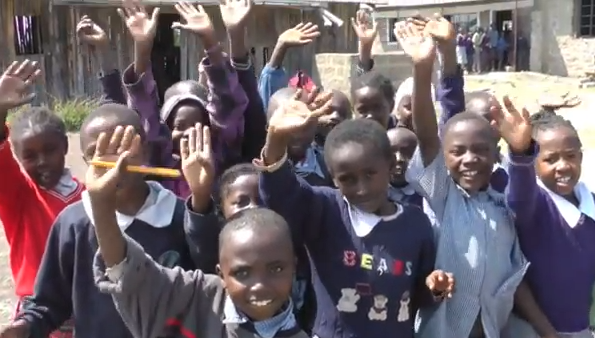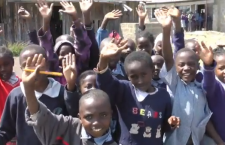[youtube=http://www.youtube.com/watch?v=5ridUTy2bEE]
Njoguini Primary School Visit
On July 27 our group of Project Kenya Sister School volunteers made the first of two visits to Njoguini Primary School. I particularly looked forward to the visits, as our school in Philadelphia, Stephen Girard Elementary School, is the sister school to Njoguini and I was anxious to learn how the students there were doing.
Last year, as an Earthwatch volunteer, I paid a visit to Njoguini. It had been a cold day, and the first sight of that school was a humbling experience. I had been unprepared for the conditions of a rural school in Kenya; particularly of a school that could enroll more than 125 students.
The classrooms were constructed of wood with a metal roof. The board slats of the walls were full of open spaces, and from the inside one could feel the wind blowing despite the cardboard and paper tacked up to provide insulation. The dirt floors of the classrooms were uneven, and looking down I could see bare toes between sandals and sneakers. I wondered how on that cold morning the children could concentrate on learning.
When we arrived at the school, one year later, I hardly recognized where we were. The wooden buildings were being gradually replaced by stone block classrooms. In the side yard there was a new garden, greenhouse, and water tank. There was a fullness about the place that felt immediately different.
Despite these positive changes, I hesitated, feeling uncertain for a moment. This was the big day, and I feared that somehow I might fail to adequately communicate the goodwill of the students from home. I also worried that in this culturally different land the material gifts that I had brought might not be useful.
I quickly pushed these thoughts aside as we were welcomed by Ms. Flora Karuoya, a Deputy Headteacher of Njoguini. We began by visiting students. The first classroom that Ms. Flora led us to was quite full and brimming with the energy of the school’s youngest students. The children ranged in age from 3 to 5 years old. And just like the kids at home, they were eager to interact with visitors. They shared the things that they had been learning including counting in English and inspirational songs. Looking into these bright faces, it seemed that the sun had just cleared out the cold.
Subsequently, in each classroom we visited, friendly curiosity overcame timidity. Even the youngest of children swarmed around us to exchange greetings, handshakes, learning, and high-fives. Several of us particularly enjoyed lessons from these young teachers in Kiswahili vocabulary. They showed us their illustrated work and sang inspirational songs wherever we visited.
A tour of the new construction brought evidence that Njoguini was turning a corner. On one side of the site new classrooms were being constructed. The structures had smooth concrete walls and were soon to have concrete floors. The classes were also being fitted with glass windows to keep out the rain and cold. As we thanked the builders, the difference in these new spaces brought tears to my eyes.
On a later visit, I learned from the school’s head teacher, Mr. Sylvester M. Mutahi, that Njoguini had won an award this year for the school with the greatest academic gains in the district. Speaking of his students he said, “The thing that I like about this school is that the children are so lively and ready to learn. You hardly get angry.”
After our tour on that first day, I had been eager to give the teachers the materials that I carried from my home school. Quickly Ms. Flora helped me separate the reading and math texts that had been donated by our Girard teachers. It seemed, however, that they were happiest to see the student-written books that had been created by some of our third-graders.
Later I would find out that Njoguini students also had some experience with publishing, and that they had illustrated a story by Astrid van Harmelen about a young boy of the Kikuyu tribe and his coming of age journey. Mr. Patrick Wairiuko, Deputy Head Teacher presented me with a copy to take home and share with our students along with the friendly letters that the students had written for our students in Philadelphia.
On both visits to Njoguini, students shared their traditional music and dance with us. It is hard to describe the power in this music. That first day, after some older students carried the books off to storage, Ms. Flora mentioned that we had not yet visited the older students, and she asked us to gather for their presentation. Several students hurried to bring us chairs and we sat along the front of the schoolyard.
The students grouped in front of us and broke out in a traditional song. One older girl, Pauline, 14, led the harmonizing in a strong rich voice. The sound was simply amazing! Suddenly a line of students filed in front of us and took our hands to dance. Happily, it was a simple skipping dance which we had recently been taught by a local Samburu tribe.
On our second visit the music was even more powerful as the entire school joined in and we discovered other strong voices, like Jakeline, 12, who alternated as lead with Pauline. By the end of the morning PA-MOJA volunteers found ourselves dancing with great enthusiasm and surrounded by all of the students as well as Mr. Sylvester. I think we all felt welcomed and privileged to be there.
In that moment I really wished that our principal, Mr. Thomas Koger, had been present. I think it was clear that he and Mr. Sylvester are kindred spirits. In an attempt to honor this connection, Madeleine Delittle and other PA-MOJA volunteers helped me teach the Njoguini students to sing Baby Beluga, a Girard favorite. I can’t wait to share these videos at school!
As I said “Kwa Heri” and waved goodbye, I had no trace of the uncertainty that I had felt upon our arrival. The students and teachers had gifted me a sense of hope to carry home for the students at Stephen Girard. I am optimistic that the cultural exchange between our schools will continue to enrich lives on two continents.
By Dawn Kane
PHOTO GALLERY
CLICK ON THUMBNAILS TO ENLARGE


